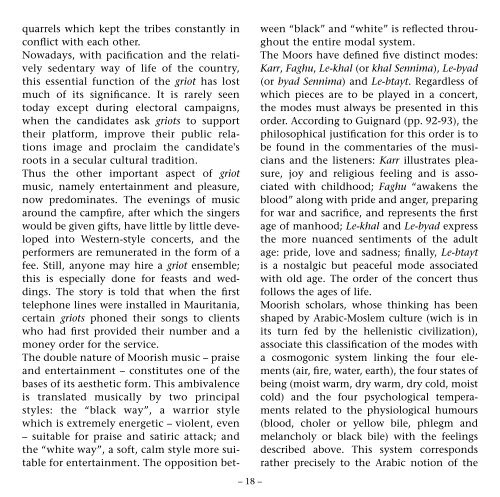AICHA MINT CHIGHALY, Mauritanie, l'art des griots ... - Free
AICHA MINT CHIGHALY, Mauritanie, l'art des griots ... - Free
AICHA MINT CHIGHALY, Mauritanie, l'art des griots ... - Free
Create successful ePaper yourself
Turn your PDF publications into a flip-book with our unique Google optimized e-Paper software.
quarrels which kept the tribes constantly in<br />
conflict with each other.<br />
Nowadays, with pacification and the relatively<br />
sedentary way of life of the country,<br />
this essential function of the griot has lost<br />
much of its significance. It is rarely seen<br />
today except during electoral campaigns,<br />
when the candidates ask <strong>griots</strong> to support<br />
their platform, improve their public relations<br />
image and proclaim the candidate's<br />
roots in a secular cultural tradition.<br />
Thus the other important aspect of griot<br />
music, namely entertainment and pleasure,<br />
now predominates. The evenings of music<br />
around the campfire, after which the singers<br />
would be given gifts, have little by little developed<br />
into Western-style concerts, and the<br />
performers are remunerated in the form of a<br />
fee. Still, anyone may hire a griot ensemble;<br />
this is especially done for feasts and weddings.<br />
The story is told that when the first<br />
telephone lines were installed in Mauritania,<br />
certain <strong>griots</strong> phoned their songs to clients<br />
who had first provided their number and a<br />
money order for the service.<br />
The double nature of Moorish music – praise<br />
and entertainment – constitutes one of the<br />
bases of its aesthetic form. This ambivalence<br />
is translated musically by two principal<br />
styles: the “black way”, a warrior style<br />
which is extremely energetic – violent, even<br />
– suitable for praise and satiric attack; and<br />
the “white way”, a soft, calm style more suitable<br />
for entertainment. The opposition bet-<br />
–18–<br />
ween “black” and “white” is reflected throughout<br />
the entire modal system.<br />
The Moors have defined five distinct mo<strong>des</strong>:<br />
Karr, Faghu, Le-khal (or khal Sennima), Le-byad<br />
(or byad Sennima) and Le-btayt. Regardless of<br />
which pieces are to be played in a concert,<br />
the mo<strong>des</strong> must always be presented in this<br />
order. According to Guignard (pp. 92-93), the<br />
philosophical justification for this order is to<br />
be found in the commentaries of the musicians<br />
and the listeners: Karr illustrates pleasure,<br />
joy and religious feeling and is associated<br />
with childhood; Faghu “awakens the<br />
blood” along with pride and anger, preparing<br />
for war and sacrifice, and represents the first<br />
age of manhood; Le-khal and Le-byad express<br />
the more nuanced sentiments of the adult<br />
age: pride, love and sadness; finally, Le-btayt<br />
is a nostalgic but peaceful mode associated<br />
with old age. The order of the concert thus<br />
follows the ages of life.<br />
Moorish scholars, whose thinking has been<br />
shaped by Arabic-Moslem culture (wich is in<br />
its turn fed by the hellenistic civilization),<br />
associate this classification of the mo<strong>des</strong> with<br />
a cosmogonic system linking the four elements<br />
(air, fire, water, earth), the four states of<br />
being (moist warm, dry warm, dry cold, moist<br />
cold) and the four psychological temperaments<br />
related to the physiological humours<br />
(blood, choler or yellow bile, phlegm and<br />
melancholy or black bile) with the feelings<br />
<strong>des</strong>cribed above. This system corresponds<br />
rather precisely to the Arabic notion of the



